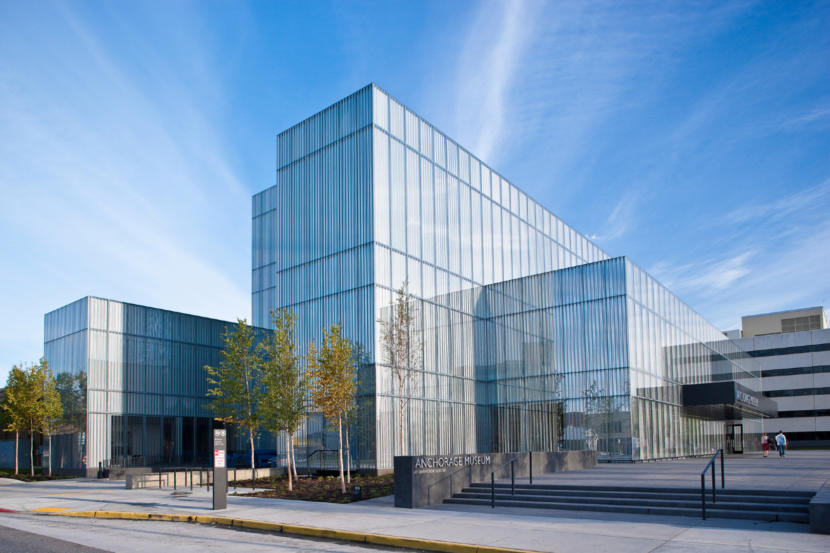
Maybe you’ve heard of a “land acknowledgment.” It’s a statement of respect at the beginning of an event acknowledging the Indigenous inhabitants of a place and their claim to the land. In some countries they have been happening for decades, even incorporated into official protocols. In Alaska, the conversation around land acknowledgment is relatively new. But it’s picking up.
“On our tour we have been doing what we’ve been calling land acknowledgments,” explained Zachary Carothers, bassist for the band Portugal. The Man in a video posted to the group’s Facebook page.
https://www.facebook.com/portugaltheman/posts/10157086442119743
In 2018, the band tried something that was new for them at concerts around the world. They opened their sets with a land acknowledgment.
“Every night, wherever we play, we ask First Nations people of the area — from there or were displaced from there,” Carothers explained.
Several members of Portugal. The Man are from Alaska and maintain close connections. The final stop of their tour was at the Alaska Airlines Center in Anchorage, where Acilquq, a Yup’ik dance troupe, opened their performance.
As a city, Anchorage has had a fraught relationship with its Indigenous history. Now major institutions are using land acknowledgments as a way to change that, placing Alaska Native heritage more centrally in the region’s identity.
One way that’s happened, for example, was a workshop hosted inside the Anchorage Museum on Thursday.
“I’m going to ask you each to write your own land acknowledgment,” said Emily Johnson, an artist and choreographer who led a discussion of about two dozen women in a small conference room.
“I do ask you to think about a few things,” Johnson said, prompting attendees in an exercise. “Where you are? What is your relationship to respect and acknowledgment? And then what are your actions?”
Johnson is of Yup’ik descent and grew up in Sterling. Now she lives in New York City, but she leads workshops like this one in countries around the globe.
“Land acknowledgment is an Indigenous protocol,” she explained. “It’s a process of knowing upon whose land you are, so that you engage in the right protocols, so that you can build those relationships, or you can ensure your safety, or you can ensure that you can hunt or fish, etc.”
Today, the acknowledgments are a form of recognition, a sign of respect that is typically offered ahead of a meeting, a conference or a presentation. According to Johnson, there is no single right way to do one. Instead, the formulation is an ongoing process.
“The ingredients certainly have intentional words that are related to respect and acknowledgment and recognition,” she said. “And action.”
Early in the workshop, participants went around the room introducing themselves. Like several of the people in attendance, Aaron Leggett, the museum’s curator for Alaska history and culture, gave his introduction in a mix of English and his Indigenous language, Dena’ina.
Leggett grew up in Anchorage and the Native Village of Eklutna, where he’s now president. In his lifetime, he’s seen a major transformation in how the region acknowledges its Dena’ina heritage. Quoting Kenaitze Elder Clare Swan, Leggett explained that for decades in the Cook Inlet area there was barely any recognition of Indigenous inhabitants — past or present.
“We were the invisible people,” Leggett said. “We were invisible to outsiders, and we were somewhat invisible even to ourselves. So I would say we’re no longer invisible, but there’s still a lot of work to be done.”
Some of that work is being taken up by local institutions like the Anchorage Museum. There are large signs outside and inside the building acknowledging the site as within the traditional Dena’ina homeland.
Though there’s no formal process in place, the museum is developing acknowledgments as part of its own internal and public-facing programs, according to Hollis Mickey, director of learning and engagement.
“I think there’s something really powerful about using our languages when we are acknowledging that this is Dena’ina land,” said Chandre Szafran, one of the attendees.
Szafran was born in Nome and still has family in the region. But she has lived most of her life in Anchorage and firmly identifies as an “Anchorage girl.” As the state’s hub, she feels the city has an important role to play in the current discussion around land acknowledgment, history and heritage.
“I’m Native, but I’m not indigenous to Anchorage. I grew up here, and I feel a strong, strong sense of connection. But this is Dena’ina land,” Szafran said. “It also has the significance of being Alaska’s biggest gathering place.”
The three-hour workshop was intended as a jumping-off point, aimed especially at educators, as a way to raise questions, talk about issues and encourage participants to try land acknowledgments in different settings.
Johnson is optimistic. As she sees it, the U.S. is not yet at the level of Canada, Australia or New Zealand, where residents have pushed beyond just acknowledging traditional lands and toward implementing policies aimed at racial equity and reparations. But in Alaska, some of those changes are happening more rapidly than many expected.
“I think about land acknowledgment in terms of shifting consciousness,” Johnson said. “That is the goal. Like, we’re shifting consciousness, we’re centering Indigenous people, and knowledge, and land. Because that is what is needed.”
The workshop is part of the museum’s SEED Lab, a new initiative focused on innovation and the exchange of ideas.
Correction: An earlier version of this story stated Emily Johnson grew up in Soldotna. She grew up in Sterling.
